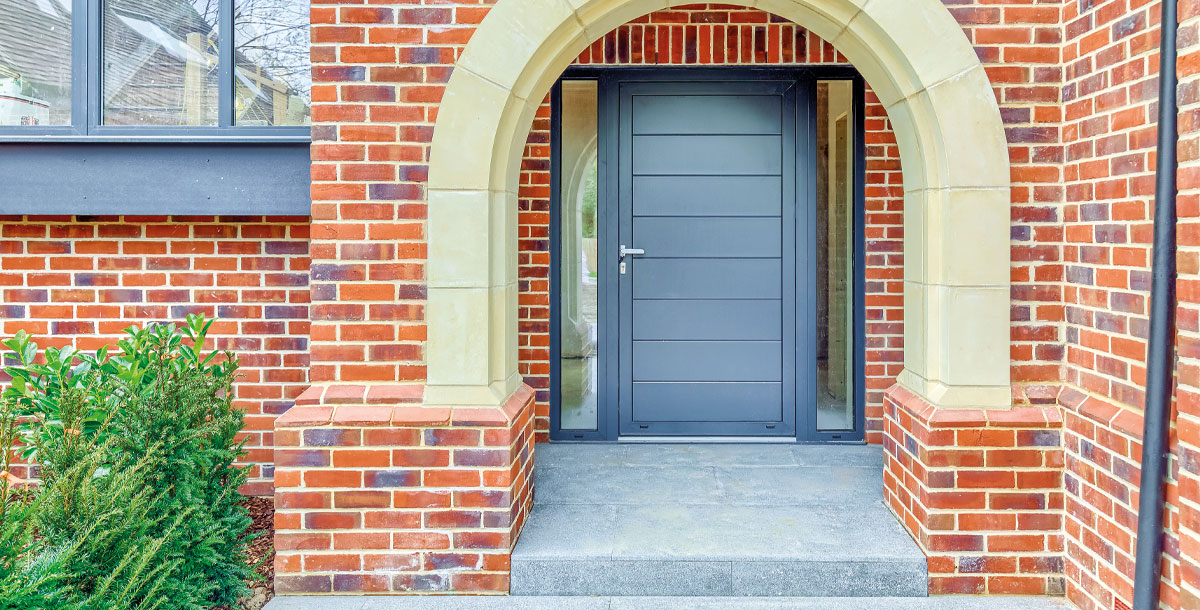Modern front door ideas
Explore the differences between metal, timber and composite constructions – plus installation tips
A modern front door presents an attractive and inviting entrance and deters unwelcome visitors with its robust construction and effective security features.
Material choices include timber, aluminium and composite, all of which are available off the shelf in standard measurements or bespoke.
Buying considerations range from selecting a design that suits your home to budget and maintenance requirements. Sidelights help keep hallways bright.
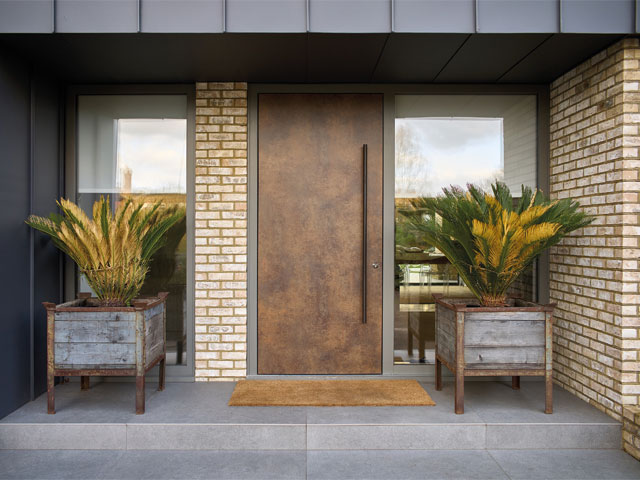
Olivo door in Patina Bronze, 2.63×2.6m, with frame in RAL 7039, triple-glazed sidelight and window, Deuren
Anticipating regulations
With new-builds and major renovation projects the front door will form part of the planning application for the entire scheme.
If you’re upgrading your home, a like-for-like replacement falls under permitted development rights (PDR) and you won’t need planning consent unless the property is listed or in a conservation area, or if you’re creating a new opening or widening the existing one. Be clear on the rules by checking with your local authority before beginning any work.
Since April 2002 all replacement window and door installations in England and Wales need to comply with Building Regulations and be registered with the local council. This is to ensure your home is safe and energy efficient.
When you sell your property, you’ll be asked for proof of this compliance. You can make the Building Regulations application yourself, or use a registered installer who can self- certify under a Competent Persons Scheme. Find out more at Front Door.
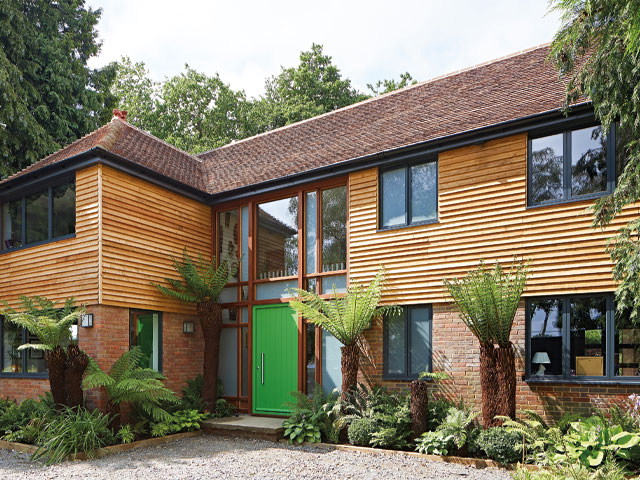
A durable paint finish gives a solid look with no wood grain visible. Hardwood Porto e80 concealed hinge doorset, 1.2×2.4m, finished in RAL 6018 with Option 8 pull handle in 316 stainless steel, Urban Front
How about metal?
Aluminium is a durable material often powder-coated for a durable, maintenance-free finish and available in any RAL colour – gloss or matt. It won’t rust and resists corrosion, making it a good choice for homes subject to harsh coastal weather.
Incorporating insulating material limits the transference of heat through the door. ‘Aluminium doors with an insulating core of polyurethane foam blocks have a U-value of 0.71 W/m2K, which is well below Building Regulation standard,’ says Matt Higgs, director of Kloeber.
Sturdy and corrosion-resistant steel-framed designs have a mineral wool, polyurethane or polystyrene foam core sandwiched between two double-skin steel panels. You can expect to pay from around £1,800 for an off-the-shelf aluminium design and £960 for a comparable steel model.
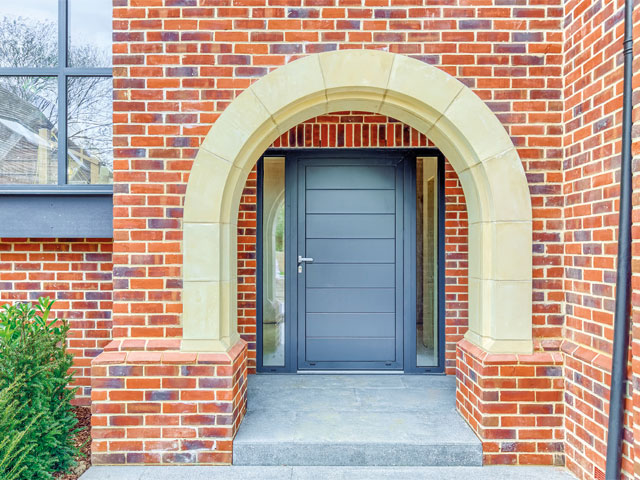
A door set with glazing creates a contemporary entrance. Powder-coated aluminium FunkyFront Dusseldorf 1 panel-style front door, 1.75×2.125m, finished in RAL 9017 Traffic Black, with sidelights and hardware, from Kloeber
Reasons to pick timber
Wooden doors are available as off-the-shelf and made-to-measure options. Solid hardwoods such as oak and beech are extremely durable, but they are also more expensive than softwoods such as pine and ash.
Modified softwoods such as Accoya go through a process that make them durable, water and rot resistant. Buying a locally produced FSC-certified design is the most eco-friendly option. As timber ages it will dry out and may crack, so it will require regular maintenance around every six to eight years.
The price of a timber door is influenced by the type of wood it’s made from, the amount of glazing required and the quality of the security fittings. An engineered oak off-the-shelf door costs from around £400, with a bespoke creation from £7,000 upwards, including installation.
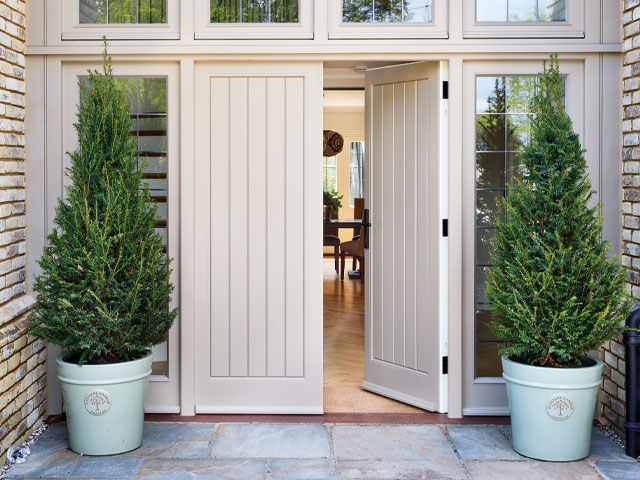
These doors were installed at the same time as the screen. Accoya double door set, 3×2.1m, surrounded by a glazed screen detailed with aged lead lines, both painted in Jenny Wren by Dulux Heritage, door by Westbury Joinery
Composite choices
Available in a wide range of designs, colours and finishes, composite doors are made from a variety of materials. Options include a steel-reinforced UPVC frame with a rigid insulation core of foam, or timber with weatherproof plastic cladding or a glass-reinforced plastic (GRP) exterior skin made from polyester resins and fibreglass.
‘GRP is moulded to enable a range of styles and designs,’ explains Ryan Schofield, director of Thames Valley Window Company. Composite construction limits heat loss and offers excellent stability, preventing warping.
GRP composite doors are more expensive than UPVC as they’re stronger, more secure and better quality. They cost from around £750, or £1,800 for a door set including installation.
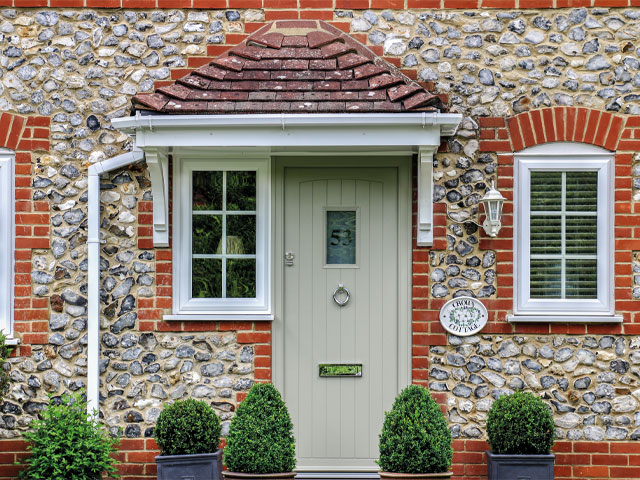
This design comes with the house number etched into the glass. Apeer Hanwell composite front door, 204x87cm, finished in Pebble Grey RAL 7032, Thames Valley Windows
Installation tips
Where possible, visit showrooms to get an idea of the quality of different suppliers’ products. Some offer a measure, supply and fit service, and those that don’t provide installation usually have a list of recommended installers/joiners.
You might want to choose an option that blends with the style, materials and colours of your home’s exterior, or opt for something that contrasts in size, hue or design to make an eye-catching impression.
When it comes to the fittings, look for Secured by Design accreditation, which ensures the quality of hinges and materials and the strength of the glass. Or select those that have been tested to PAS 24 standard, so they meet part Q of the Building Regulations for security.
Front doors require safety glass, manufactured by tempering or a laminating process, to ensure strength and resistance to breakage. When an existing door frame is in good condition, replacing the door alone is possible, but the fit must be snug with no gaps. If the frame is worn, swap the entire unit for a pre-hung installation.
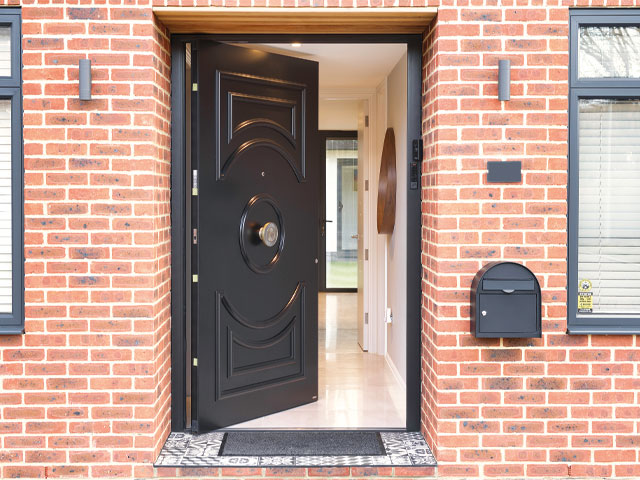
Pivot doors have hinges at the bottom and top instead of on the side. RK7060 aluminium pivot door, in RAL 9005 black, from RK Door Systems
Fast facelifts
Refurbishing advice and ideas from Elizabeth Assaf, owner of Urban Front.
- Prevent draughts and heat loss by replacing all the weather seals around the door – not just at the bottom. I recommend Silicone Door Seal, £10.99 for 10m, Amazon, or Stormguard Heavy Duty Around Door Seal Aluminium, £17.99, Toolstation. Keyholes and letterboxes let in draughts, so fit an escutcheon and a letterbox flap or brush.
- When refinishing a timber design, sand the surface back to get a smooth and clean base first. This enables you to see any blemishes that need filling. In terms of paint, soft sheen options are more durable, retain colour better and are easier to clean than matt formulas.
- Consider professional restoration to upgrade the glazing and draughtproofing of an original period door to improve its energy efficiency.
- Clean good-quality stainless steel or brass door furniture or hardware with products recommended by the manufacturer.

